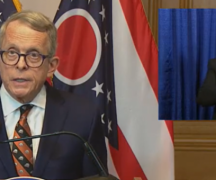The United States has the largest incarceration rate in the world. If the average daily population of those held behind bars in the United States were a city, it would have a larger population than Columbus, Cleveland, Cincinnati, and Dayton combined.
While mass incarceration has always had devastating consequences for individuals, families, and communities, it is also currently threatening to exacerbate the Coronavirus crisis. Jails and prisons often keep those incarcerated in close quarters, and many held behind bars have health risks that make them more vulnerable.
A complaint filed with the Supreme Court of Ohio by an individual currently incarcerated described the crisis: “[T]he bed areas are so crowded that I am within three feet of at least twelve people and those twelve are in the same position …. This means that there are 126 people in my ‘dorm’ that are within 3-4 feet of each other.”
In other words, it is not possible to follow social distancing directives behind bars, and therefore inmates and staff are at a greater risk of being exposed to the virus, and spreading it both within and outside of facilities.
To promote public health and safety, across the country and here in Ohio, criminal legal system stakeholders are jumping into action to quickly decrease their jail populations, and in doing so, are demonstrating that decarceration measures could and should have been in effect all along.
Cuyahoga County was an early national standout, as the county’s prosecutor, public defender, and administrative and presiding judge all worked together to hold Saturday hearings in order to expedite cases and decrease the jail population. As a result, the jail’s population decreased from over 1,900 on March 9 to 1,463 on March 18, and the Juvenile Detention Center is refusing to detain youth arrested for misdemeanors and its population decreased from 115 to 97 in less than two weeks.
Similarly, the jail population in Franklin County decreased by 300 people, and Hamilton County’s jail population decreased by an astounding 668 people in just a few weeks. It’s not just the larger counties in Ohio that have sprung into action. The Richland County Jailreduced its population from 223 inmates to 176 in one week. The Butler County Jailreduced its population from 1,033 to 873 in a week and a half. The Montgomery County Jailreleased over 300 inmates in fewer than ten days. And these aren’t the only examples. Many of the individuals released were only in jail in the first place because they couldn’t afford to pay cash bail, or they were serving time for misdemeanors. (See story on Wood County’s response.)
However, while jails are rapidly releasing people, Ohio does not have current plans to reduce its prison population, currently at 127% capacity, which is dangerous inaction likely to lead to unnecessary death.
Thankfully, the jails that have quickly and drastically decreased their populations have done so due to the leadership of stakeholders deploying a number of different decarceration strategies.
As Chief Justice Maureen O’Connor encouraged, many judges have held hearings to reduce or remove cash bonds that had been holding pretrial — legally innocent — individuals in jail, not because of what they had done, but because they did not have the money necessary to pay for their release.
Sheriff and police departments have also expanded cite and release practices, which means instead of bringing a person accused of a crime to jail, where they may have stayed for days if not weeks if they could not have afforded to post bond, the individual will instead receive a citation and a date on which they are required to go to court.
Some legislators have also stepped up to the plate; members of the Cuyahoga County Ohio House Delegation sent a letter to the Ohio Department of Youth Services encouraging the agency to release youth who can be supervised in the community rather than put at greater risk in detention.
These rapid jail depopulation measures raises the question: If we are releasing individuals to promote public health and safety now, can we morally and truthfully claim we should resort back to incarcerative practices once the crisis is over and still claim doing so promotes public safety? What if the goal of decarceration was our new normal?
Every day in Ohio, judges set cash bail as a condition of release, which for those unable to afford their release is the same as a detention order. Similarly, many in Ohio are arrested and brought to jail for misdemeanors and non-violent felonies, when they could have easily been cited and provided a court date.
Those forced to remain in jail suffer unimaginable consequences: they are put at risk of losing their job, their home, and even custody of their children. They even have worse case outcomes. Those who remain in jail pretrial, compared with those arrested for the same crime who are able to pay for their release, are more likely to get convicted, are more likely to be sentenced to jail and prison, and receive sentences that are two to three times longer. This makes a mockery of our criminal legal system because it’s clear that it is poverty, not guilt, we are criminalizing.
Our over-reliance on pretrial, wealth-based detention also costs us. On average in Ohio it costs $65 per jail bed per day to hold someone pretrial. On average, pre-pandemic, over 11,000 pretrial individuals were held in Ohio’s jails each day, for an annual cost of $266 million. And this number does not include the cost of the prison population we know is enlarged by those who suffer worse consequences because they were detained during pretrial, nor does it account for the depressed work force that results from people losing their jobs because they are unnecessarily held.
These emergency release measures have had no known negative effect on public safety. Which makes sense, because our over-reliance on cash bail does not promote public safety, it just allows wealthy people to buy their release, while those who cannot afford cash bail suffer in jail.
Similarly, embracing cite and release policies for non-violent crimes allows police officers to save time usually spent arresting and booking an individual, which allows them to return more quickly to patrol duties and respond to incidents in which people may actually be in danger.
Decreasing our reliance on cash bail and increasing cite and release practices long-term would decrease wealth-based detention, promote justice and humanity during the pretrial process, save tax payer dollars, and promote public safety.
The dedication of judges, prosecutors, public defenders, sheriffs, police officers, and legislators across our state has led to a rapid decrease in the number of Ohioans unnecessarily held behind bars, which has undoubtedly saved lives during this global health crisis. But these measures can be life-saving long after we have survived this pandemic.
We need to call on these same actors to not revert to previous, incarcerative ways, which have harmed Ohioans since their inception. Let’s allow these changes to be a silver lining during this terrifying time, and work together to ensure we do not go back to our harmful over-reliance on cash bail and unnecessary detention. Our state can be the best version of itself even without a crisis.

Claire Chevrier is Policy Counsel at the ACLU of Ohio where she is responsible for leading their statewide advocacy on bail reform. Before joining the ACLU of Ohio, Claire worked for a nonprofit in Washington, D.C. where she represented youth with special education needs who were in the juvenile and/or criminal justice systems. Working in the D.C.-Maryland-Virginia area provided Claire with the frustrating experience of navigating different pretrial systems. Washington, D.C. has eliminated cash bail, while Maryland and Virginia still heavily rely on it. Depending on where clients were arrested, they’d either likely go home to their families, or suffer in jail for weeks if not months. Claire is dedicated to bringing bail reform to Ohio and tearing down its unconstitutional wealth-based detention system. Claire is a graduate of Georgetown University Law Center.





